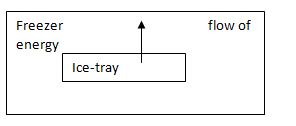
(a)
Interpretation:
The direction of energy transferred in the process of conversion of water to ice is to be discussed.
Concept introduction:
Whenever the state of a substance changes, a transfer of heat takes place.
Conversion of solid to liquid or liquid to gas requires heat and gas to liquid or liquid to solid releases heat.
(a)
Answer to Problem SI4RE
Energy is transferred from water to the freezer.

Explanation of Solution
When the water is in a liquid form in the freezer, it is converted to ice which is a solid form. A fixed amount of energy is released when liquid is converted to solid. So, there is a transfer of energy from water to the freezer.
(b)
Interpretation:
The energy transferred in the process of conversion of water to ice is whether endothermic or exothermic for ice tray is to be discussed.
Concept introduction:
Whenever the state of a substance changes, a transfer of heat takes place.
Conversion of solid to liquid or liquid to gas requires heat and gas to liquid or liquid to solid releases heat.
A process is endothermic when there is an absorption of heat and exothermic when there is a release of heat.
(b)
Answer to Problem SI4RE
The process is exothermic for the ice tray.
Explanation of Solution
When the water is in a liquid form in the freezer, it is converted to ice which is a solid form. A fixed amount of energy is released when liquid is converted to solid. So, there is a transfer of energy from water to the freezer. So, the process is exothermic by virtue of tray.
(c)
Interpretation:
The amount of heat transferred for one ice cube is to be calculated.
Concept introduction:
Whenever the state of a substance changes, a transfer of heat takes place.
Conversion of solid to liquid or liquid to gas requires heat and gas to liquid or liquid to solid releases heat.
A process is endothermic when there is an absorption of heat and exothermic when there is a release of heat.
The amount of heat released when 1 mol of water freezes is called enthalpy of freezing.
(c)
Answer to Problem SI4RE
Amount of heat released
Explanation of Solution
The heat released when 1 mol water freezes
Density of water=
Therefore,
Thus,heat released when
So, heat released when
(d)
Interpretation:
The amount of heat transferred for full ice tray is to be calculated.
Concept introduction:
Whenever the state of a substance changes, a transfer of heat takes place.
Conversion of solid to liquid or liquid to gas requires heat and gas to liquid or liquid to solid releases heat.
A process is endothermic when there is an absorption of heat and exothermic when there is a release of heat.
The amount of heat released when 1 mol of water freezes is called enthalpy of freezing.
(d)
Answer to Problem SI4RE
Amount of heat released
Explanation of Solution
The heat released when 1 mol water freezes
Density of water=
Therefore,
Thus,heat released when
So, heat released when
Number of moulds in ice tray
Therefore,
Heat released when full tray is frozen
Chapter U5 Solutions
Living By Chemistry: First Edition Textbook
Additional Science Textbook Solutions
CHEMISTRY-TEXT
Chemistry: Structure and Properties (2nd Edition)
Organic Chemistry (9th Edition)
Inorganic Chemistry
Chemistry: A Molecular Approach
General Chemistry: Principles and Modern Applications (11th Edition)
 ChemistryChemistryISBN:9781305957404Author:Steven S. Zumdahl, Susan A. Zumdahl, Donald J. DeCostePublisher:Cengage Learning
ChemistryChemistryISBN:9781305957404Author:Steven S. Zumdahl, Susan A. Zumdahl, Donald J. DeCostePublisher:Cengage Learning ChemistryChemistryISBN:9781259911156Author:Raymond Chang Dr., Jason Overby ProfessorPublisher:McGraw-Hill Education
ChemistryChemistryISBN:9781259911156Author:Raymond Chang Dr., Jason Overby ProfessorPublisher:McGraw-Hill Education Principles of Instrumental AnalysisChemistryISBN:9781305577213Author:Douglas A. Skoog, F. James Holler, Stanley R. CrouchPublisher:Cengage Learning
Principles of Instrumental AnalysisChemistryISBN:9781305577213Author:Douglas A. Skoog, F. James Holler, Stanley R. CrouchPublisher:Cengage Learning Organic ChemistryChemistryISBN:9780078021558Author:Janice Gorzynski Smith Dr.Publisher:McGraw-Hill Education
Organic ChemistryChemistryISBN:9780078021558Author:Janice Gorzynski Smith Dr.Publisher:McGraw-Hill Education Chemistry: Principles and ReactionsChemistryISBN:9781305079373Author:William L. Masterton, Cecile N. HurleyPublisher:Cengage Learning
Chemistry: Principles and ReactionsChemistryISBN:9781305079373Author:William L. Masterton, Cecile N. HurleyPublisher:Cengage Learning Elementary Principles of Chemical Processes, Bind...ChemistryISBN:9781118431221Author:Richard M. Felder, Ronald W. Rousseau, Lisa G. BullardPublisher:WILEY
Elementary Principles of Chemical Processes, Bind...ChemistryISBN:9781118431221Author:Richard M. Felder, Ronald W. Rousseau, Lisa G. BullardPublisher:WILEY





